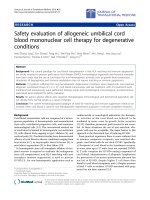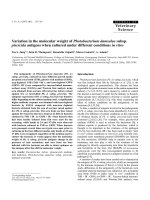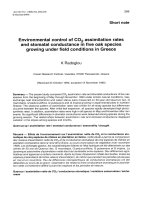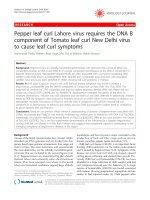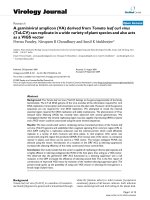Evaluation of elicitors against tomato leaf curl disease (ToLCD) under field conditions
Bạn đang xem bản rút gọn của tài liệu. Xem và tải ngay bản đầy đủ của tài liệu tại đây (325.44 KB, 7 trang )
Int.J.Curr.Microbiol.App.Sci (2020) 9(8): 2191-2197
International Journal of Current Microbiology and Applied Sciences
ISSN: 2319-7706 Volume 9 Number 8 (2020)
Journal homepage:
Original Research Article
/>
Evaluation of Elicitors against Tomato Leaf Curl Disease (ToLCD)
under field conditions
Puja Pandey*, R. G. Parmar and A. B. Brahmbhatt
Department of Plant Pathology, B. A. College of Agriculture, Anand Agricultural University,
Anand, Gujarat – 388 110, India
*Corresponding author
ABSTRACT
Keywords
Tomato leaf curl,
Elicitors, Disease
incidence
Article Info
Accepted:
20 July 2020
Available Online:
10 August 2020
In the present investigation different chemical elicitors viz., dipotassium
hydrogen sulphate (400 mM), potassium sorbate (7.5%), sorbic acid
(7.5%), salicyclic acid (100mM) and chitosan (1%) and biological elicitors
viz., Trichoderma spp. (0.6%) and Pseudomonas spp. (0.5%) were used for
seedling root dip treatment to check their resistance developing efficacy
against ToLCD. Significant maximum percent control over disease
(77.91%) was found in seedling root dip with salicylic acid (0.1 mM) and
foliar spray at 15 and 30 DAT followed by sorbic acid treatment @ 1.5%
i.e. 64.52%. Whereas, treatments were almost at par with each other.
Introduction
In nature, plants are often simultaneously or
sequentially
attacked
by
numerous
herbivorous insects and microbial pathogens
(fungal, bacterial, and virus). In case of
tomato crop, several biotic and abiotic factors
are the major constraints in production of
tomato in India. Among these viral diseases,
tomato leaf curl disease (ToLCD) is
devastating and causes significant yield loss
under severe conditions. Tomato yellow leaf
curl disease (TYLCD) has been a global
constraint to tomato (Solanum lycopersicum)
production since the 1980s (Moriones and
Navas-Castillo (2000). Infected susceptible
tomato plants show symptoms that include
yellowing, curling and cupping of leaves,
severe stunting and abortion of flowers and
fruits, all of which can lead to yield reduction
of up to 100% (Abhary et al., 2007). The
investigation of plant response to elicitors and
bio-control agents is one of the most rapidly
developing areas in plant pathology.
Many non-biological factors, such as salicylic
acid (SA), benzothiadiazole (BTH), and
methyl jasmonate (MeJA), have been reported
to induce plant resistance (Eyre et al., 2006).
Induced resistance includes induced systemic
resistance (ISR) and systemic acquired
resistance (SAR). It has been identified that
2191
Int.J.Curr.Microbiol.App.Sci (2020) 9(8): 2191-2197
the untranslatable messenger RNA (mRNA)
of a PR protein can be converted into a
translatable state through the exogenous
application of SA to tobacco (Matsuoka et al.,
1986). Moreover, SA can regulate the ROS
levels in plants by controlling the activity of
protective enzymes and avoiding or
eliminating the plant cell damage caused by
oxygen stress. In tomato, the exogenous
application of SA can increase phenylalanine
ammonia lyase (PAL) and POD activities and
induce and enhance tomato plant resistance to
Fusarium oxysporum f. sp. Lycopersici
(Mandal et al., 2009).
Controlling TYLCV is difficult and is mainly
based on intensive insecticide treatments that
are used to control the vector populations
(Palumbo et al., 2001). However, this method
is harmful to the environment (Navot et al.,
1991) and has limited success because it
selects for insecticide-resistant populations in
B. tabaci (Cahill et al., 1996; Elbert and
Nauen, 2000). The best way to manage
TYLCV is to enhance host plant resistance
against this virus. Among synthetic chemical
inducers, salicylic, sorbic and benzoic acids
have been found to be active as antimicrobial
agents in various trials as disease resistance
inducers. Also, they have been reported for
inducing resistance against several plant
pathogens (Abdel-Kader, et al., 2012).
In the present investigation different
biological and chemical elicitors have been
used to check their resistance developing
efficacy against TYLCD.
Raising of tomato nursery
Tomato seedlings of variety AT -3 were
raised in nursery under protected condition.
Seedling root dip treatment followed by
transplanting
Chemical elicitors viz., dipotassium hydrogen
sulphate (400 mM), potassium sorbate
(7.5%), sorbic acid (7.5%), salicyclic acid
(100mM) and chitosan (1%) and biological
elicitors viz., Trichoderma spp. (0.6%) and
Pseudomonas spp. (0.5%) were used for
seedling root dip treatment for 2 hrs and 30
min respectively before transplanting (Table
1). Untreated check was also maintained. But
some treatments viz. salicylic acid (100 mM),
sorbic acid @ 75 g/L and potassium sorbate
@ 75 g/L were found to be toxic at their
respective concentration as it lead to death of
seedlings.
Hence, retransplanting was done after treating
the seedlings at lower concentration. New
treatment that were tested is as follows:
1. T4 (Salicylic acid): 0.1mM (@ 0.14 mg/L
water)
2. T7 (Sorbic acid): 1.5% (@ 15 g/L water)
3. T8 (Potassium sorbate): 1.5% (@ 15 g/L
water)*
* Still this treatment was found toxic.
Foliar application in field
Materials and Methods
Present investigation was carried in polyhouse
at the Department Plant Pathology and
experimental farm, B. A. College of
Agriculture, Anand Agricultural University,
Anand.
Two foliar spray with dipotassium hydrogen
sulphate (400 mM), potassium sorbate
(1.5%), sorbic acid (1.5%), salicyclic acid
(0.1mM) and chitosan (1%) and biological
elicitors viz., Trichoderma spp. (0.6%) and
Pseudomonas spp. (0.5%) was done at 15 and
30 days after transplanting.
2192
Int.J.Curr.Microbiol.App.Sci (2020) 9(8): 2191-2197
Disease incidence
Before first spray
Disease incidence was recorded as the
number of root rot diseased plants relative to
the number of planted seedlings in each
treatment.
The disease incidence was found significantly
lower (0.37%) in the treatment salicylic acid
(0.1 mM) which was at par with sorbic acid
(1.5%) treatment i.e. 0.45 per cent. Other
treatments were found to be significantly less
effective than salicylic acid and sorbic acid
treatment but almost found at par with each
other, showing minimum disease incidence
over control.
DI
=
No. of infected plants X 100
Total no. of plant assessed
Results and Discussion
This experiment was conducted to evaluate
the different biological and chemical plant
resistance inducers against tomato leaf curl
disease (ToLCV) under field conditions.
After transplanting
The data presented in the table 2 indicated
that treatments viz., salicylic acid @ 100 mM,
sorbic acid @ 7.5 % and potassium sorbate @
7.5% were found to be toxic to seedling.
Hence, further retransplanting was done after
lowering the dose of these treatment viz.
salicylic acid @ 0.1mM (0.014 mg/L water),
Sorbic acid @ 1.5% (15 g/L water) and
Potassium sorbate @ 1.5% (15 g/L water).
First spray
Disease incidence was recorded at 7 days and
15 days after first spray and it was recoded
that in the pooled data of both observations,
the disease incidence was found significantly
lower (4.55%) in the treatment of salicylic
acid (0.1 mM) which was at par with sorbic
acid (1.5%) treatment i.e. 6.53 per cent.
Other treatments were found to be
significantly less effective than salicylic acid
and sorbic acid treatment but found at par
with each other, showing minimum disease
incidence over the control.
Table.1 Treatment details
Sr. No.
T1
T2
T3
T4
T5
T6
T7
T8
T9
T10
Treatment details
Seedling root dip in formulation of Pseudomonas fluorescens (1x108 cfu/ml) WP 1% @ 0.5% followed by foliar spray at 15
and 30 DAT
Seedling root dip in formulation of Trichoderma asperellum (2x106 cfu/ml) WP 1% @ 0.6% followed by foliar spray at 15
and 30 DAT
Seedling root dip in formulation of Trichoderma viride (2x106 cfu/ml) WP 1% @ 0.6% followed by foliar spray at 15 and 30
DAT
Seedling root dip in salicylic acid (0.1 mM) @ 0.14 mg/L followed by foliar spray (25 mM) @ 3.45g/L at 15 and 30 DAT
Seedling root dip in chitosan WP 4% @ 1g/L followed by foliar spray at 15 and 30 DAT
Seedling root dip in dipotassium hydrogen phosphate WP (100 mM) @ 17.42 g/L followed by foliar spray (100 mM) @
17.42 g/L at 15 and 30 DAT
Seedling root dip in sorbic acid @ 15 g/L followed by foliar spray @ 25 g/L at 15 and 30 DAT
Seedling root dip in potassium sorbate @ 15 g/L followed by foliar spray @ 25 g/L at 15 and 30 DAT
Chemical control (Acetamiprid 20 SP @ of 2g/10L)
Control (Untreated)
2193
Int.J.Curr.Microbiol.App.Sci (2020) 9(8): 2191-2197
Table.2 Evaluation of different chemical and biological plant resistance inducers against tomato leaf curl disease (ToLCD) under field
conditions, depicting plant disease incidence
Sr.
No.
Treatments
10.14ab
(3.10)
23.67a
(16.12)
32.27ab
(28.51)
27.97d
(22.00)
36.03b
(34.60)
38.62bc
(38.96)
37.33cd
(36.77)
Pooled
over
period
and
sprays
32.65ab
(29.11)
18.37a
(9.93)
28.33a
(22.52)
35.61ab
(33.90)
31.97abc
(28.03)
38.01ab
(37.92)
39.59bc
(40.61)
38.8c
(39.26)
35.38ab
(33.52)
16.36
13.29ab
(5.28)
29.13a
(23.70)
37.96ab
(37.84)
33.55ab
(30.54)
39.51ab
(40.48)
41.29ab
(43.54)
40.4b
(42.01)
36.97ab
(36.17)
9.75
3.48b
(0.37)
7.68 b
(1.79)
16.95d
(8.50)
12.32e
(4.55)
20.78d
(12.59)
23.81e
(16.30)
22.99g
(15.25)
17.31c
(8.85)
77.91
10.86ab
(3.55)
10.56ab
(3.36)
26.86a
(20.41)
26.99a
(20.60)
32.35ab
(28.63)
34.83ab
(32.62)
29.61cd
(24.41)
30.91bcd
(26.39)
34.84b
(32.64)
36.83b
(35.93)
36.45c
(35.30)
38.22bc
(38.28)
35.64e
(33.95)
37.53c
(37.11)
32.63ab
(29.07)
34.22ab
(31.63)
27.47
3.84b
(0.45)
6.75 b
(1.38)
22.85c
(15.08)
14.8e
(6.53)
28.39c
(22.61)
30.63d
(25.96)
29.51f
(24.26)
22.15c
(14.22)
64.52
20.89a
(12.71)
21.9a
(13.91)
49.15
24.89a
(17.71)
30.80a
(26.22)
27.63
31.86b
(27.86)
38.42a
(38.62)
10.43
28.37d
(22.58)
34.61a
(32.26)
18.45
34.81b
(32.59)
43.06a
(46.62)
7.96
37.04c
(36.29)
44.79a
(46.62)
5.48
35.93de
(34.43)
43.93a
(48.13)
6.58
32.15b
(28.32)
39.28a
(40.08)
12.56
29.34
Before spray
1
2
3
4
5
Seedling root dip in formulation of Pseudomonas
fluorescens (1x108 cfu/ml) WP 1% @ 0.5% followed
by foliar spray at 15 and 30 DAT
Seedling root dip in formulation of Trichoderma
asperellum (2x106 cfu/ml) WP 1% @ 0.6% followed
by foliar spray at 15 and 30 DAT
Seedling root dip in formulation of Trichoderma
viride (2x106 cfu/ml) WP 1% @ 0.6% followed by
foliar spray at 15 and 30 DAT
Seedling root dip in salicylic acid 99-100%, CDH
product (0.1 mM) @ 0.014mg/L followed by foliar
spray (0.1 mM) @ 0.014mg/L at 15 and 30 DAT
Seedling root dip in Chitosan WP 4% @ 1g/L
followed by foliar spray at 15 and 30 DAT
8
Seedling root dip in Dipotassium hydrogen phosphate
WP (100 mM) @ 69.68 g/L followed by foliar spray
(100 mM) @ 17.42 g/L at 15 and 30 DAT
Seedling root dip in sorbic acid @ 1.5% (15 g/L)
followed by foliar spray @ 1.5% (15 g/L) at 15 and
30 DAT
Chemical control (Acetamiprid 20 SP @ of 2g/10L)
9
Control (Untreated)
6
7
C. V. %
Note: Values outside parenthesis are
Percent disease incidence*
1st spray
1st week
2nd week
Pooled
1st week
2nd spray
2nd week
Pooled
transformed values while, figures in the parenthesis are original values; Treatment means with the letter (s) in common are not significant by DNMRT at 5% level of
significance.
2194
Per cent
control
over
disease
27.37
21.08
9.71
Int.J.Curr.Microbiol.App.Sci (2020) 9(8): 2191-2197
Fig.1 AUDPC („A‟ value) and apparent rate of infection („r‟ value)
Second spray
Disease incidence was recorded at 7 days and
15 days after second spray and it recoded that
in the pooled data of both observations, the
disease incidence was found significantly
lower (15.25%) in the treatment salicylic acid
(0.1 mM) which was at par with sorbic acid
(1.5%) treatment i.e. 24.26 per cent. Other
treatments were found to be significantly less
effective than salicylic acid and sorbic acid
treatment but almost at par with each other,
showing minimum disease incidence with
respect to control.
Percent control over disease from pooled
data of both the sprays
Significant maximum percent control over
disease (77.91%) was found in case of
seedling root dip in salicylic acid (0.1 mM)
followed by foliar spray at 15 and 30 DAT
followed by sorbic acid treatment @ 1.5%
i.e. 64.52% . Other treatments were found at
par with each other (Table 2).
AUDPC (‘A’ value) and apparent rate of
infection (‘r’ value)
The AUDPC values differed considerably for
different treatments. „A‟ value was found
minimum in T4 (218.505) with infection rate
of 0.108 followed by T7 (365.925) with 0.116
rate of infection. The maximum AUDPC
(1002.61) was recorded in control with
infection rate of 0.035 (Fig. 1).
Several studies have demonstrated the
efficacy of exogenous application of SA
analogue (BTH) for controlling fungal and
bacterial diseases (Siegrist et al., 1997; Cole
1999), the effect of which is in the form of
induced resistance. However, induced
resistance to viruses through exogenous
application of SA or its functional analogue
has been demonstrated in only few studies.
The resistance of tobacco to subsequent
infection of TMV is found to be enhanced by
pre-treatment of plants with aspirin or SA
(White, 1979). Ong and Cruz (2016) reported
that exogenous application of SA can delay
the development and reduce the severity of
tomato leaf curl disease. At shorter induction
time of 5 dbi, treatment with 50 and 250µM
SA effectively reduced leaf curl infection
compared with the untreated control, but the
reduction was greater with treatment of higher
concentration
(250µM)
than
lower
concentration (50µM). However, at longer
induction time of 10 and 15 dbi, reduction of
leaf curl infection was highest with treatment
of 50µM SA. Overall, reduction in the
2195
Int.J.Curr.Microbiol.App.Sci (2020) 9(8): 2191-2197
severity of tomato leaf curl was consistent
with treatment of 50µM SA at 15 days before
inoculation. Likewise, the application of
100µM BTH as a soil drench, 7 days before
inoculation with CMV-Y, protected plants
against the virus (Anfoka, 2000). SA is an
endogenous signal for the activation of certain
plant defense responses, including PR-gene
expression and the consequent establishment
of enhanced resistance (Klessig, 2000).
In conclusion the tomato leaf curl disease is
one of the devastating diseases and has been
reported to be associated with several
begomoviruses, thus making breeding for
resistance more challenging. The above
results suggest that SA can enhance tomato
plant resistance through systemic acquired
resistance.
References
Abdel-Kader, M.M., El-Mougy, N.S., ElGammal, N.G., Abd-El-Kareem, F.,
and Abd-Alla M.A. (2012). Laboratory
evaluation of some chemicals affecting
pathogenic fungal growth. J. Appl. Sci.
Res. 8: 523-530.
Abhary, M., Patil, B. L., and Fauquet, C. M.
(2007).
“Molecular
biodiversity,
taxonomy, and nomenclature of tomato
yellow leaf curl-like viruses,” in
Tomato Yellow Leaf Curl Virus
Disease: Management, Molecular
Biology, Breeding for Resistance, ed.
H. Czosnek (Dordrecht: Springer), 85–
118.
Anfoka, G.H. (2000). Benzo-(1, 2, 3)thiadiazole-7-carbothioic
acid
Smethyl
ester
induces
systemic
resistance in tomato (Lycopersicon
esculentum Mill cv.Vollendung) to
cucumber
mosaic
virus.
Crop
Protection 19: 401-405.
Cahill, M., Gorman, K., Day, S. and
Denholm,
I.
(1996).
Baseline
determination and detection of
resistance to imidacloprid in Bemisia
tabaci (Homoptera: Aleyrodidae). Bull
Entomol Res 86: 343–349.
Cole, D.L. (1999). The efficacy of
acibenzolar-S-methyl, an inducer of
systemic acquired resistance against
bacterial and fungal diseases of
tobacco. Crop Prot. 18:267-273.
Elbert, A. and Nauen, R. (2000). Resistance
of Bemisia tabaci (Homoptera:
Aleyrodidae) to insecticides in
southern Spain with special reference
to neonicotinoids. Pest Manag Sci 56:
60–64.
Eyre, J. X., Faragher, J. and Joyce, D. C.
(2006). Effects of postharvest methyl
jasmonate treatments against Botrytis
cinerea on Geraldton waxflower
(Chamelaucium uncinatum). Aust J
Exp Agr.; 46 (5):717–23.
Klessig, D.F. (2000). Nitric oxide and
salicylic acid signaling in plant
defense. Proc. Natl. Acad. Sci. USA.
97:8849-8855.
Mandal S, Mallick N. and Mitra A. (2009).
Salicylic acid-induced resistance to
Fusarium
oxysporum
f.
sp.
lycopersici in tomato. Plant Physiol
Biochem.; 47(7):642–9.
Matsuoka, M. and Ohashi, Y. (1986).
Induction of pathogenesis-related
proteins in tobacco leaves. Plant
Physiol.; 80(2): 505–10.
Moriones, E., and Navas-Castillo, J. (2000).
Tomato yellow leaf curl virus, an
emerging virus complex causing
epidemics worldwide. Virus Res. 71,
123–134.
Navot N, Pichersky E., Zeidan, M. and
Czosnek H. (1991). Tomato yellow
leaf curl virus: a whitefly-transmitted
geminivirus with a single genomic
component. Virology 185: 151–161.
Ong, S. and Cruz, F. C. S. (2016). Effect of
exogenous application of salicylic acid
2196
Int.J.Curr.Microbiol.App.Sci (2020) 9(8): 2191-2197
on the severity of tomato leaf curl
disease. J. ISSAAS . 22 (1): 137-145.
Palumbo, J. C., Horowitz, A. R. and
Prabhaker, N. (2001). Insecticidal
control and resistance management for
Bemisia tabaci. Crop Prot., 20: 739–
765.
Siegrist, J. D., Glenewinkel, C. K. and
Schmidtke, M. (1997). Chemically
induced resistance in green bean
against bacterial and fungal pathogens.
J. Plant Dis. Prot. 104: 599-610.
White, R.F. (1979). Acetyl salicylic acid
(aspirin) induces resistance in tobacco.
Virology. 99: 410-412.
How to cite this article:
Puja Pandey, R. G. Parmar and Brahmbhatt, A. B. 2020. Evaluation of Elicitors against Tomato
Leaf Curl Disease (ToLCD) under Field Conditions. Int.J.Curr.Microbiol.App.Sci. 9(08): 21912197. doi: />
2197
